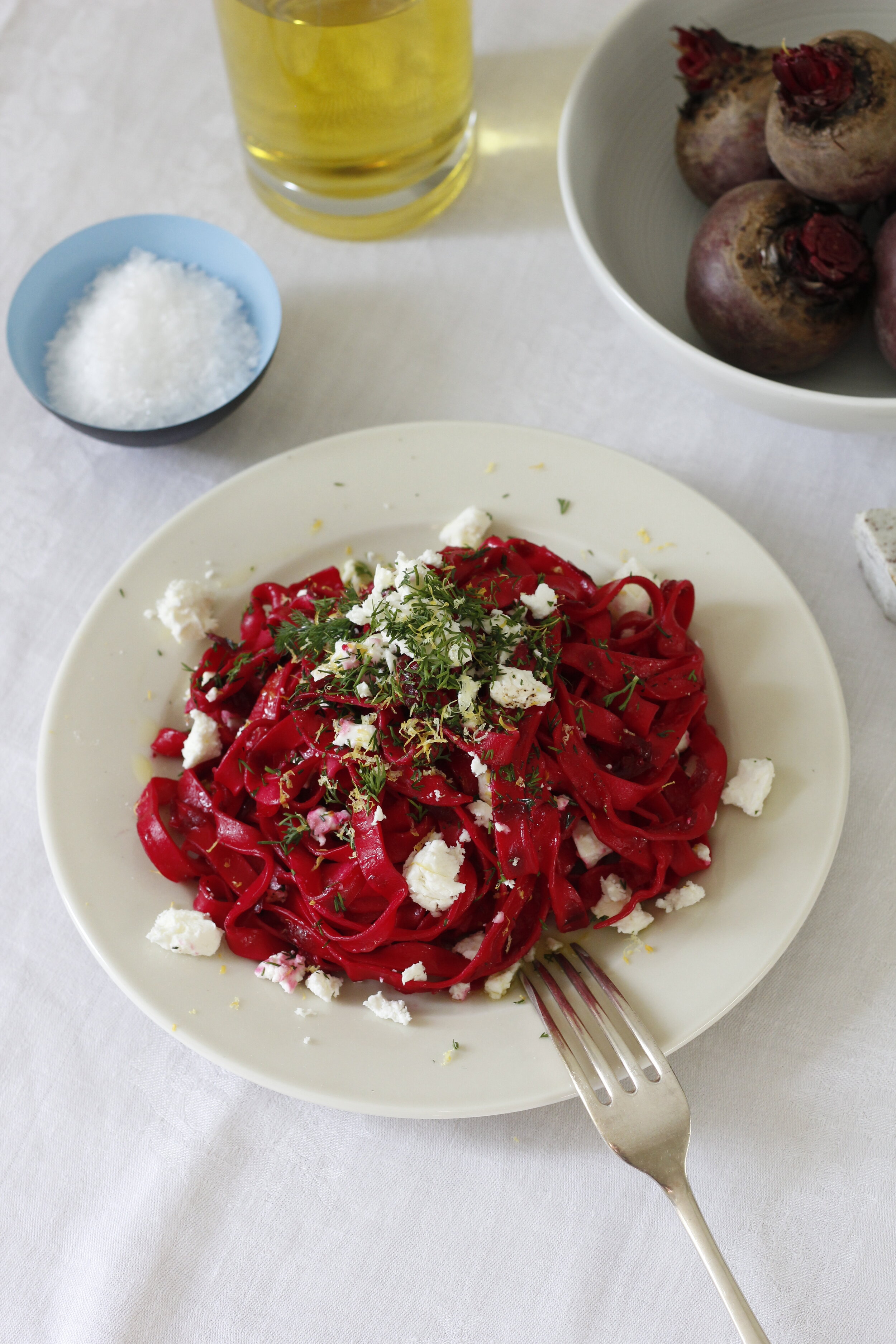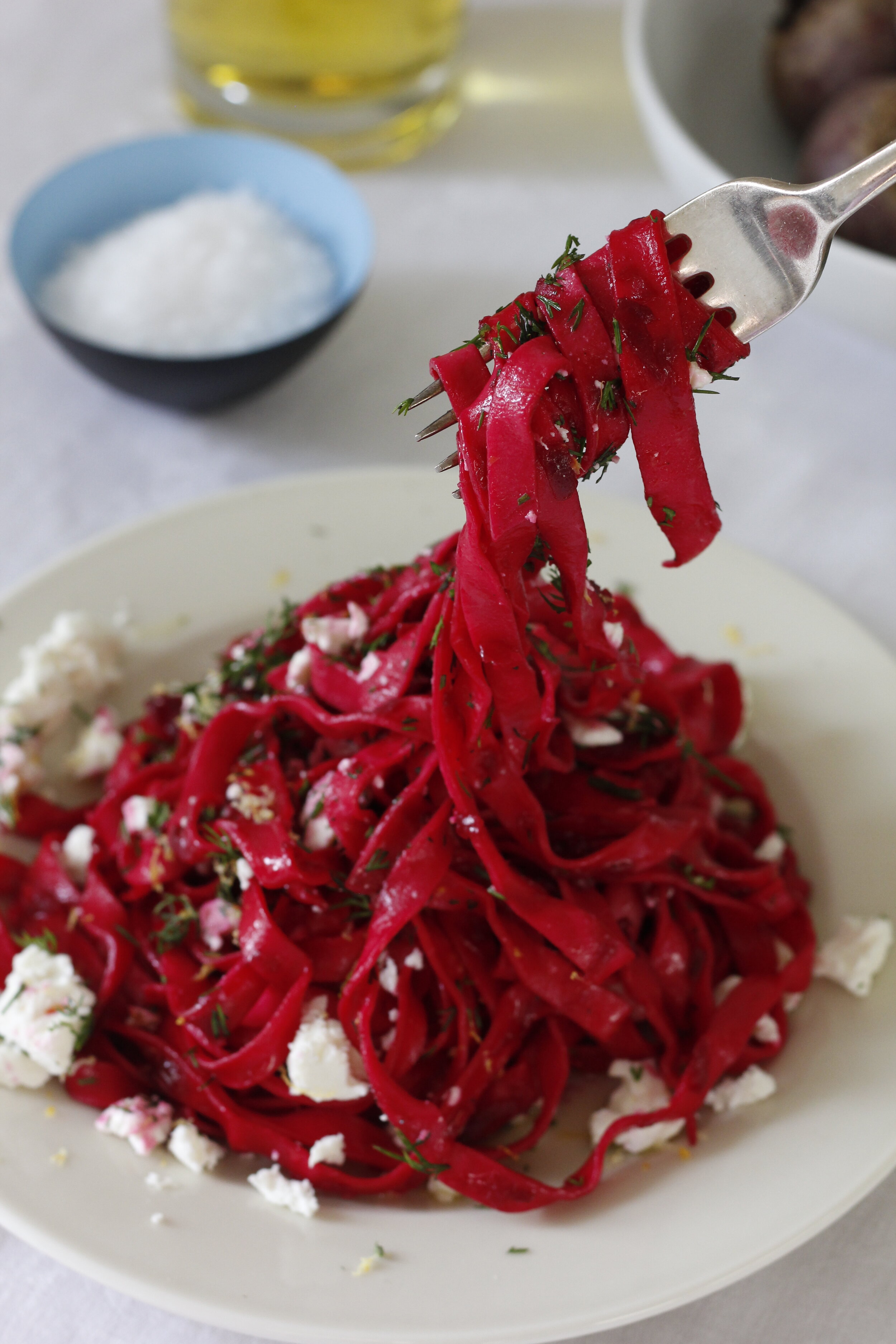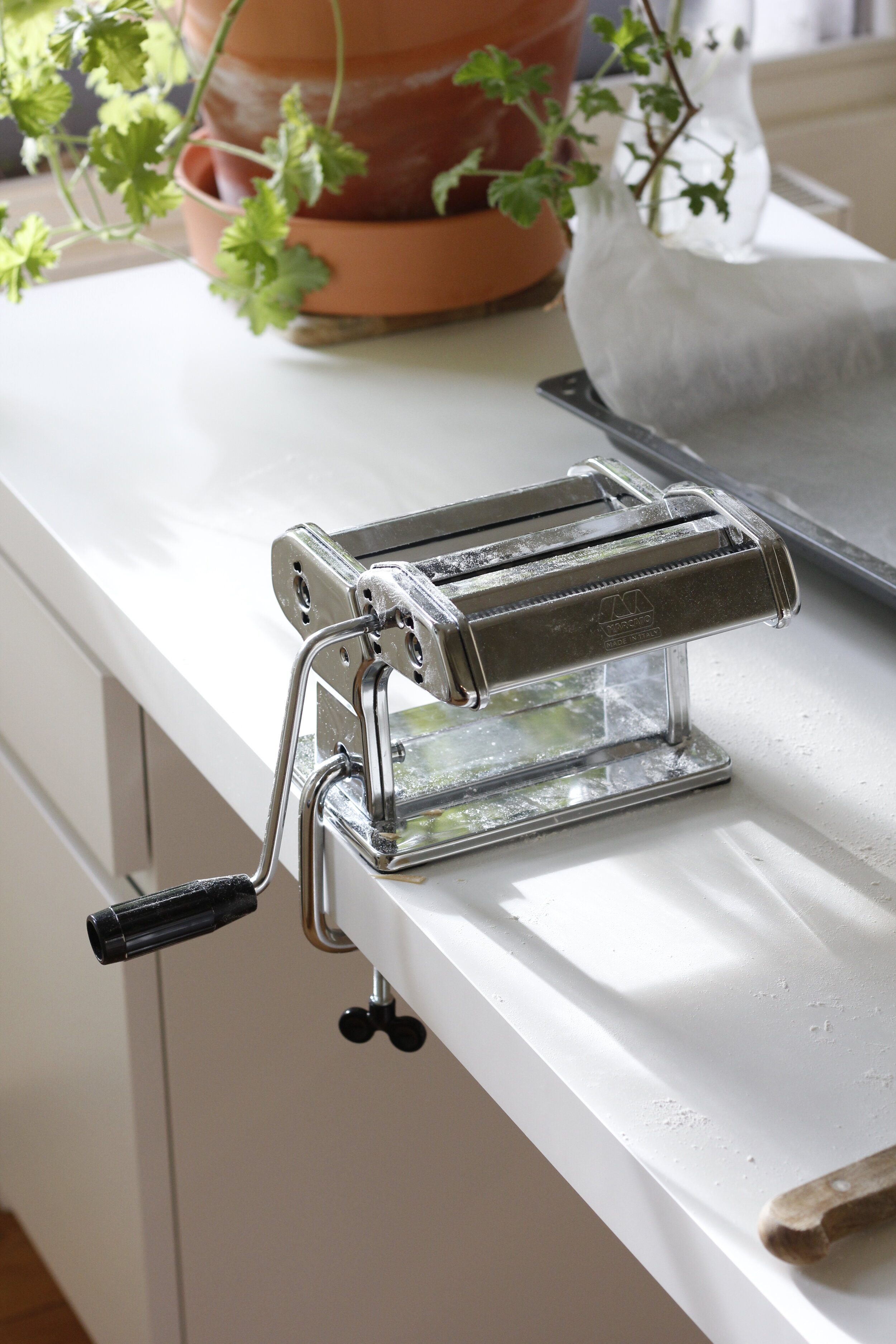Bright Pink Pasta
This bright pink homemade pasta is a colourful recipe to brighten these dark January days. I wanted to use seasonal produce and fell in love with the zingy colour of British beetroots, and the combination of their beautiful earthy flavour with fresh dill, lemon juice and feta on top. Make sure to wear an apron or something you don’t mind staining for preparing the beetroot as it manages to go everywhere, and the colour will stain.
People make pasta dough in lots of different ways: some with lots of yolks to give the pasta a rich yellow colour and taste, some with both yolks and whites like the recipe below, and some use water instead of eggs, which is vegan friendly and very economical (it was done this way during the war when eggs were harder to get hold of). It is also common to use 50g semolina flour and 150g 00 tipi flour combined for the flour quantity.
As this is a recipe for another @stillherestilllife x @platetalks live cooking video collaboration, I am very excited to see how this vibrant colour is recreated in illustrated form. One illustrator has even promised to use beetroot juice as ink for her drawing.
This recipe makes enough for 4 people. If you need visual aids, please watch the video here. But please bear in mind, the recipe here has been amended from the original Instagram recipe, as my quantities were too large.
Ingredients (pasta dough):
200g Tipi 00 flour
2 large eggs
1 tbsp olive oil (optional, but I think it makes the pasta softer and tastier)
1 tsp fine sea salt
(extra flour for dusting)
For cooking:
1.5l boiling water
1 tbsp fine sea salt
Ingredients (beetroot sauce):
3 tbsp olive oil
2 cloves of garlic
200g raw beetroot (peeled weight)
pinch of flaked sea salt
30g nonpareille (small) capers
juice of 1 lemon
pinch of freshly ground black pepper
Ingredients (toppings):
10g fresh dill
50g fresh feta (optional)
lemon zest
1 tbsp good olive oil
pinch of flaked sea salt
pinch of freshly ground black pepper
Method (pasta dough):
This dough will need to rest for at least 30 minutes before it is used, so make sure to factor this into your timings.
Put the flour in a large mixing bowl and make a well in the middle.
Crack the eggs into the well in the flour, and beat the eggs together, don’t mix in the flour just yet.
Add the olive oil into the well.
Using a fork, bring the flour in from the edges of the well into the egg and olive oil, and mix it all together until it comes to a consistency that you can start bringing together with your hands.
Use your fingertips, begin to bring the dough together even more, until you can pick it up as one mass and put it onto a chopping board or clean work surface.
Now we begin to knead. In the beginning, the mixture may still appear very dry and flakey, but the more you knead it, the more it will come together and develop the gluten, which is what makes the pasta springy. This stage just takes some time and love, so knead the dough for about 10 minutes.
Stop when the dough starts to feel smooth and silky instead of rough and floury. It should be a lovely yellow colour as the flour has been absorbed.
Cover the dough tightly so it doesn’t dry out (I wrap it in baking paper with a clip to seal the edge and then put it in a Tupperware) and place it in the fridge to rest for at least 30 minutes in the fridge.
Method (beetroot sauce):
Once the pasta dough has rested for half an hour or more, start to make the beetroot sauce.
Wash the beetroots well, remove the stalks and leaves (keep the good leaves for a lovely salad!) and peel the outer skin off.
Wash the dill really well, dry, and finely chop everything but the thicker stems at the end, making sure to keep a few whole sprigs for decoration.
On the widest grate of the box grater, grate the beetroots. You can choose to grate it finer, but I like the texture that the wider setting gives to the dish.
Heat a medium-sized pan on a medium heat, and add the two tablespoons of olive oil to the pan.
Then, use a garlic press to press the two cloves of garlic into the olive oil. You could also finely chop the garlic cloves instead. Leave to cook for about two minutes, stirring well so as not to burn the garlic.
Next, add the grated beetroot and a pinch of flaked sea salt to the pan and stir well. Adding salt at this stage, rather than just at the end, helps draw out the moisture from the beetroot and stops it burning. (If you want to read more about using salt, I recommend reading Thom Eagle’s book “Summers lease”)
Leave to cook for about four minutes.
Add the capers, the juice of half a lemon, and a few twists of pepper and leave to cook for about 10 minutes.
Turn off the heat until later.
Method (rolling the pasta):
In preparation for cooking the pasta, boil a full kettle of water and pour it into a pot. Put the lid on and turn on the hob on the lowest heat to keep it warm.
For rolling the pasta, you can either use a pasta machine or of course a good old fashioned rolling pin, although it is harder to get it as fine with the rolling pin. If you are using a machine, make sure it's clamped firmly to a clean work surface before you start (use the longest available work surface you have). Dust your work surface with some Tipo ‘00’ flour.
Start by dividing the dough into two with a sharp knife. Set one half aside under a clean, damp tea towel.
Using your fingertips, flatten the other half with your hands.
Set the pasta machine at its widest setting (0 on my machine), and roll the flattened ball of dough through it.
Click the machine down a setting (1 on my machine) and roll the pasta dough through again.
Lightly dust both sides of the dough with flour and fold it in half.
Repeat steps 5, 6 and 7 another five times, so it has been through this process six times in total. It might seem long-winded, but this process is working the dough so that it is more consistent and a lot smoother.
The next stage is to run the dough through all the settings on the machine, from the widest (0 on my machine) down to around the narrowest (7 on my machine). Lightly dust both sides of the pasta with a little flour every time you run it through.
When you've got down to the narrowest setting, fold the pasta in half, then in half again, and then in half again until you've got a rectangular/square piece of dough.
Then roll the sheet of dough down through the settings up to (and including) number 5. I have found this to be the perfect thickness on our machine for tagliatelle, but for other pasta like ravioli, you would have to make the pasta thinner so you can see your hand through it. This also depends on your machine so have a play!
Lightly dust the sheet with flour and place under the clean damp tea towel until ready to cut.
Repeat steps 4 - 12 for the second ball of dough.
Once you've rolled all of the dough to the right thickness, you need to shape or cut it straight away as pasta dries much quicker than you think. Fix the cutting attachment to your machine, lightly dust the pasta sheet with flour, and roll the sheets of pasta through to cut it into tagliatelle. You could also use a knife with a ruler instead. Lay each nest of tagliatelle on a tray with baking paper, dusted with flour and cover with the clean damp tea towel again while you cut the rest.
Method (cooking the pasta/sauce):
Once you’ve cut your pasta, turn up the heat under the boiling water pot, and wait until the water is at a rolling boil.
Add the tbsp of fine sea salt to the boiling water. Many say that pasta water should be salted so that it tastes like the ocean.
Turn on the heat of your beetroot pan and add the juice from the other half of the lemon to deglaze the pan and bring it back to life.
Then add your pasta to the boiling water, stir, and cook for about 4 - 4.5 minutes. It’s important to try the pasta as it cooks to make sure you cook it enough but not too much.
Once the pasta is cooked to your liking, use a pair of tongs to lift the pasta over to the beetroot pan. Doing it this way means that you get some of that starchy goodness from the water added to the sauce. You can also drain it in a sieve, but make sure to keep half a cup of the pasta water.
Mix the pasta around in the beetroot for a couple of minutes until it turns a beautiful deep magenta colour, which means it has soaked in the delicious flavours too.
Plate up the pasta, crumble the feta, sprinkle the chopped dill and grate some lemon zest on top, and then drizzle with delicious, good quality oil and a grind of pepper.





